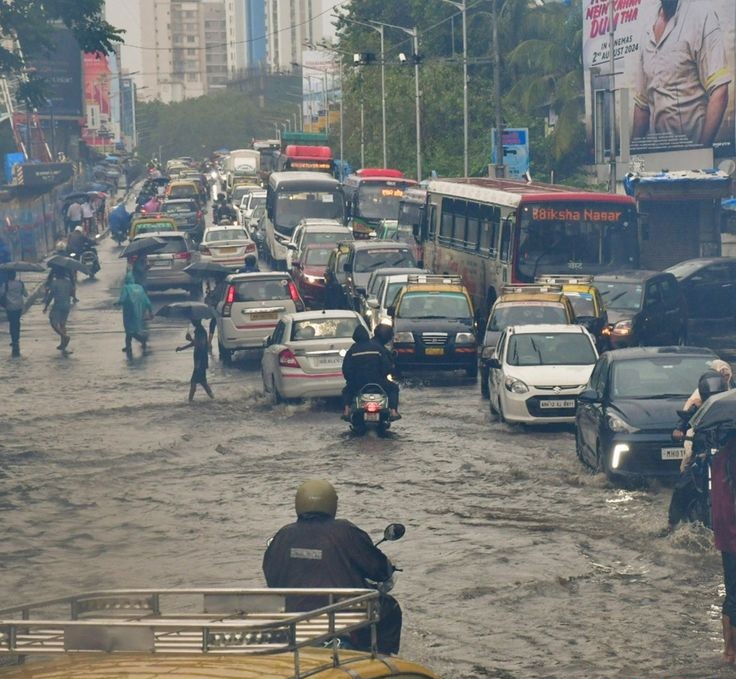With Mumbai receiving nearly 78% of its annual rainfall within just the last two months, the city now stares at another looming crisis as the Indian Meteorological Department (IMD) issues a red alert, forecasting heavy to very heavy rainfall over the next 48 hours.

With Mumbai receiving nearly 78% of its annual rainfall within just the last two months, the city now stares at another looming crisis as the Indian Meteorological Department (IMD) issues a red alert, forecasting heavy to very heavy rainfall over the next 48 hours.
Mumbai Under Red Alert
The financial capital of India is once again on high alert. Mumbai and the neighboring territories are under a red alert from the IMD due to exceptionally heavy rains, thunderstorms, and gusty winds. As the monsoon intensifies, civic authorities, disaster management teams, and residents are on edge, recalling the city’s history of severe waterlogging and disruptions.
According to the IMD bulletin issued on Monday, rainfall intensity in Mumbai is expected to cross 200 mm in 24 hours in certain pockets, particularly in the suburbs. This figure, officials say, places the event in the category of “extremely heavy rainfall”, warranting the highest-level warning under the IMD’s four-tier color-coded system.
🟢 Green Alert (No Warning)
→ Weather is normal. No major rainfall expected. Safe to carry on daily activities.
🟡 Yellow Alert (Be Aware)
→ Heavy rain likely at isolated places.
→ Advisory: Stay alert, keep an umbrella/raincoat, check local updates.
🟠 Orange Alert (Be Prepared)
→ Very heavy to extremely heavy rainfall expected in many places.
→ Advisory: Be prepared for disruptions in transport, waterlogging, and flooding. Authorities remain on standby.
🔴 Red Alert (Take Action)
→ Extremely heavy rainfall very likely.
→ Advisory: Take action to protect life and property. Schools, offices may remain shut. NDRF and civic bodies deployed. Travel should be avoided.
The Meteorological Picture
In addition to powerful offshore troughs along the Maharashtra-Goa coastline, the red signal coincides with an active monsoon trough that is sweeping throughout central India. These meteorological conditions have resulted in moisture-laden winds from the Arabian Sea converging over Mumbai, leading to sustained heavy downpours.
Dr. Mohan Sharma, senior IMD scientist, explained:
“Mumbai is currently experiencing one of the most intense monsoon phases in recent years. Our models indicate continuous heavy spells with localized cloudbursts, especially in western suburbs and low-lying areas. Citizens are advised to avoid unnecessary travel.”
Satellite images further reveal that cumulonimbus clouds, associated with thunderstorms and intense rainfall, are dominating the Konkan belt, indicating the possibility of flash floods in urban areas.
Rainfall Data So Far
Mumbai has already recorded 2,145 mm of rainfall since June, compared to the seasonal average of 2,350 mm. This means that in just two months, the city has already received over 91% of its normal monsoon quota. If the IMD is correct, the seasonal total should exceed 120% of the average rainfall by September.
Breaking down the data further:
- Colaba station (South Mumbai) has recorded around 1,630 mm so far.
- Santacruz station (Western suburbs) has crossed 2,230 mm, highlighting the uneven but intense distribution of rainfall across the city.
Civic Preparations Underway
250 water pumps have been placed in flood-prone areas, and the Brihanmumbai Municipal Corporation (BMC) has turned on its emergency control room. More than 3,000 civic workers have been deployed across vulnerable wards to clear drains, man pumps, and coordinate relief measures.
BMC Commissioner Iqbal Singh Chahal addressed the press:
“We urge citizens to stay indoors during peak rainfall hours. All schools and colleges will remain shut tomorrow in light of the red alert. Emergency services, including fire brigades and NDRF teams, are on standby.”
Railways, often the worst-hit during monsoons, have announced the cancellation of some local train services on vulnerable stretches. BEST buses, too, are expected to be rerouted in areas experiencing waterlogging.
Government Appeals and Advisory
The Maharashtra government has urged residents to remain indoors and avoid venturing into coastal areas. Fishermen have been warned against venturing into the rough seas, with wind speeds expected to touch 60–70 km/h along the Konkan coast.
The National Disaster Response Force (NDRF) has positioned five rescue teams in and around Mumbai to respond to emergencies such as building collapses, flooding, or landslides in hilly areas.
Chief Minister Eknath Shinde comforted the public via social media:
“All necessary measures are being taken. The safety of Mumbaikars is our priority. Please follow official advisories and cooperate with authorities.”
Rainfall Data: The Deluge in Numbers
Mumbai’s rainfall has reached record levels this monsoon season:
- Mumbai recorded 312 mm of rainfall in the last 24 hours, the highest single-day rainfall in the past five years.
- The city has already received 68% of its monthly average rainfall for August in just three days.
- The suburban belt, including Andheri, Kurla, and Dadar, reported waterlogging up to 3–4 feet in low-lying pockets.
- The Yamuna River level surpassed the 205.33-meter danger barrier at 205.5 meters.
Thane, Palghar, Raigad, and Mumbai districts are under a red alert, according to the IMD, due to “extremely heavy rainfall at isolated places.”
Schools and Colleges Shut
The Brihanmumbai Municipal Corporation (BMC) declared that all schools and institutions in Mumbai, Thane, and Navi Mumbai will be closed due to safety concerns. The decision was welcomed by parents as several routes leading to schools were submerged in knee-deep water.
Students, however, expressed mixed reactions—some relieved by the break, while others worried about delayed exams. Online classes were suggested for higher grades, but power cuts in many areas disrupted even that option.
Yamuna River Level: Rising Concerns
While Mumbai grapples with heavy rains, the rising Yamuna river levels have added another layer of worry. The water level has surpassed the danger mark, leading to evacuations in parts of Delhi and nearby towns.
The Central Water Commission (CWC) warned that continued rainfall in the upper catchment areas of Himachal Pradesh and Uttarakhand could worsen the situation. Authorities have started moving people from flood-prone regions near the riverbanks, with nearly 1,200 families already relocated.



Pingback: Jammu & Kashmir Cloudburst:13 Killed in Vaishno Devi..
Pingback: Six Hours for 12 Km: Gurugram Traffic Nightmare Heavy Rain